How Are Commercial Shrimp Processed?
- 12 Apr, 2023
- 4812 views
Whole raw shrimp should be processed at factories close to the ports of landing. Unless freezing facilities are available on board the catcher, all processing, including cooking, is better done ashore. Inshore species of shrimp as well as deepwater shrimp can be cooked and further processed on shore under more hygienic conditions with little loss of quality if they are iced at sea immediately after capture.
Freezing of Whole Shrimp
The methods described earlier for freezing shrimp at sea are equally applicable on shore, provided the chilled raw material is frozen within 2-3 days of capture; the thawed product can then be used for further processing in the same way as fresh shrimp.
Cold Storage of Whole Shrimp
Whole shrimp, raw or cooked, frozen individually in air blast or in blocks with water in a plate freezer, will keep in good condition in cold store at -30°C for at least 6 months. Individually frozen whole shrimp will keep for 3-4 months in good condition at -20°C, and for only 1 month at -10°C; whole shrimp stored at -10°C are more difficult to peel when thawed. Blocks of shrimp with added water will keep a little longer at these temperatures, up to 6 months at -20°C and 2-3 months at -10°C. It is recommended that wherever possible whole shrimp being stored for an indefinite period should be kept at -30°C.
Raw and cooked frozen whole shrimp develop cold store odours and flavours during storage, and the higher the storage temperature, the more quickly they develop. Shrimp cooked after freezing and cold storage are usually paler in colour than shrimp that are cooked before freezing. Both raw and cooked whole shrimp must be adequately protected against dehydration during cold storage, either by glazing or by suitable packaging; the shell of the shrimp provides no protection. Glazing should be inspected periodically and renewed as required.
>> Shop for Zolim Shrimp Cooling Machine here
Thawing of Frozen Whole Shrimp
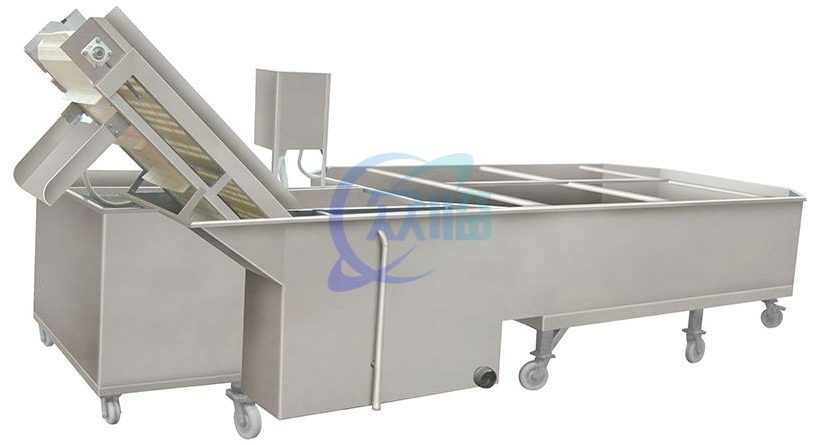
Shrimp Defrost Machine
Blocks of whole shrimp frozen at sea or on shore can be thawed in air or water. Thawing times for a typical commercial block measuring 1050 mm × 530 mm × 50 mm thick and containing about 18 kg shrimp and 6 kg water are as follows; 20 hours in still air at 18°C, 2 hours in saturated moving air at 18°C, 1½ hours immersed in water at 18°C and 1 hour in a water spray at 18°C. The water spray method is the fastest because the fine jets help to break up the block as individual shrimp thaw on the surface, thus exposing a greater surface area. With each of the methods, the blocks are soft enough to break up by hand before the shrimp are fully thawed, but it is difficult to do this without damaging some of the shrimp.
The thawed shrimp can be further processed in the same way as whole chilled shrimp.
Individually frozen shrimp can be thawed in a few minutes, or they can be cooked directly from the frozen state.
>> Shop for Zolim Shrimp Defrost Machine here
Size Grading
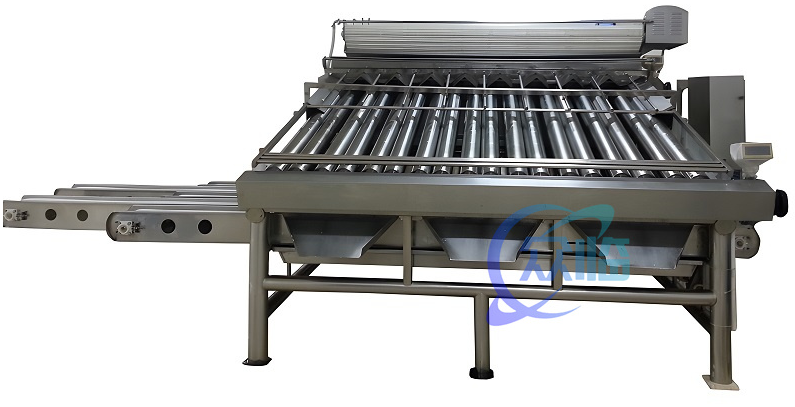
Grading Machine with 18 Rollers
Whole raw shrimp on receipt at the factory are first graded for size, since large shrimp are generally more valuable than small ones, and mechanical peelers require a supply of shrimp within a fixed size range. Small shrimp that are uneconomic to peel are either discarded or are used in chopped form as raw material for various products.
>> Shop for Zolim Prawn Grading Machine here
Cooking
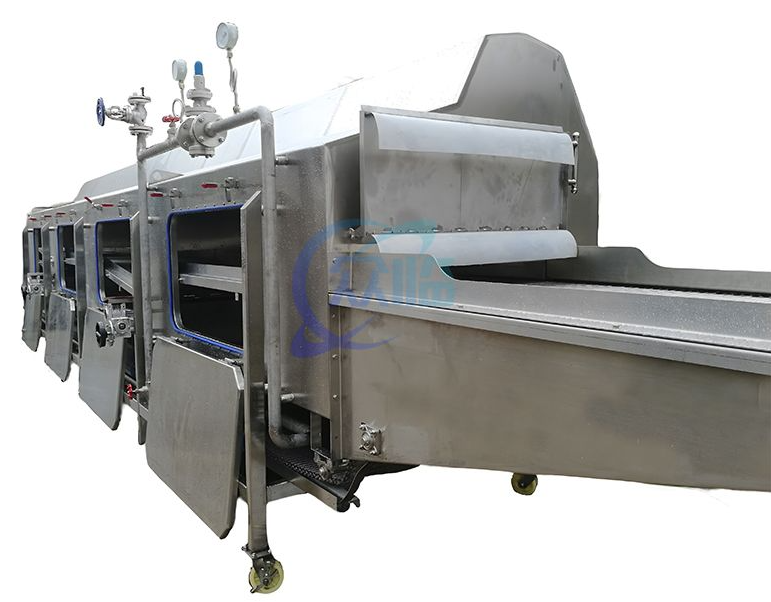
Shrimp Cooking Machine
Shrimp are cooked to provide a product that is ready to eat, and to loosen the meat in the shell prior to peeling.
The cooking process can be more easily controlled on shore than at sea; more space is available, better heating systems can be used, and instrumentation is more practicable. A short brisk cook is better than a long slow one. The ratio of shrimp to water should be as low as possible, so that the water returns to the boil as quickly as possible after the shrimp have been put in. With a ratio of 1 kg shrimp to 20 litres of water, the temperature of the water will fall initially to about 95°C, and there should be sufficient heat available to bring it back to the boil in 1-2 minutes. The water in the boiler should contain 3-5 per cent salt; the use of stronger brines can cause discoloration of the meats during subsequent chilled storage.
Cooking time is important; about 3 minutes is usually sufficient for UK shrimp, but the precise time for a certain size or quality of shrimp should be determined by experiment. The boiling time should be long enough to develop fully the flavour and texture of the shrimp meat, and to loosen the meat from the shell; overcooking can destroy the flavour and can cause loss of weight.
A lidded wire mesh basket can be used for immersing the batches of shrimp, and the basket of shrimp should be agitated gently in the water to ensure uniform cooking. Scum should be removed from the surface of the water as often as possible, and the water in the boiler changed frequently, preferably several times a day.
>> Shop for Zolim Shrimp Cooking Machine here
Cooling
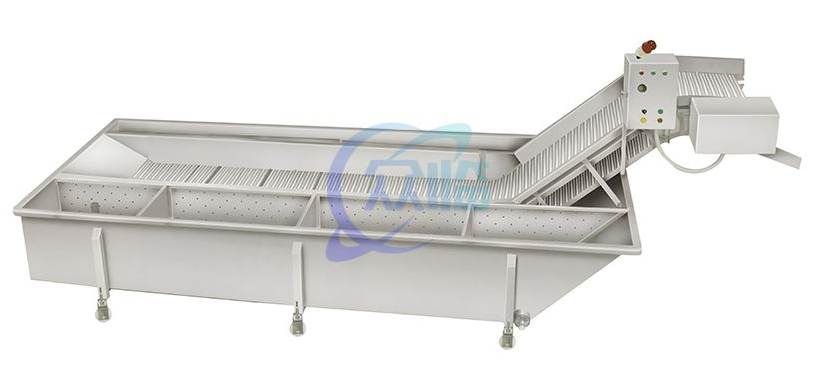
Shrimp Cooling Machine
The shrimp should be cooled immediately after cooking. Cooling in air is claimed to give the whole cooked shrimp a better colour but, unless the shrimp are to be marketed in this form, it is recommended they be cooled in water. The yield of meat from water cooled shrimp can be up to 4 per cent higher than from air cooled shrimp. They can either be immersed direct into chilled water for about 3 minutes until they are at a temperature of about 0°C, or they can be cooled in two stages, first in water at tap delivery temperature and then in chilled water. The latter method will be more economic in terms of ice or mechanical refrigeration. The shrimp should never be left to soak any longer than is necessary to chill them. As soon as they are down to chill temperature, they should be lifted out, drained, packed in clean boxes and transferred either direct to the peeling area or into a chillroom. Water and ice used for cooling must be clean; hygiene is important, and a chlorination system may be necessary.
>> Shop for Zolim Shrimp Cooling Machine here
Peeling
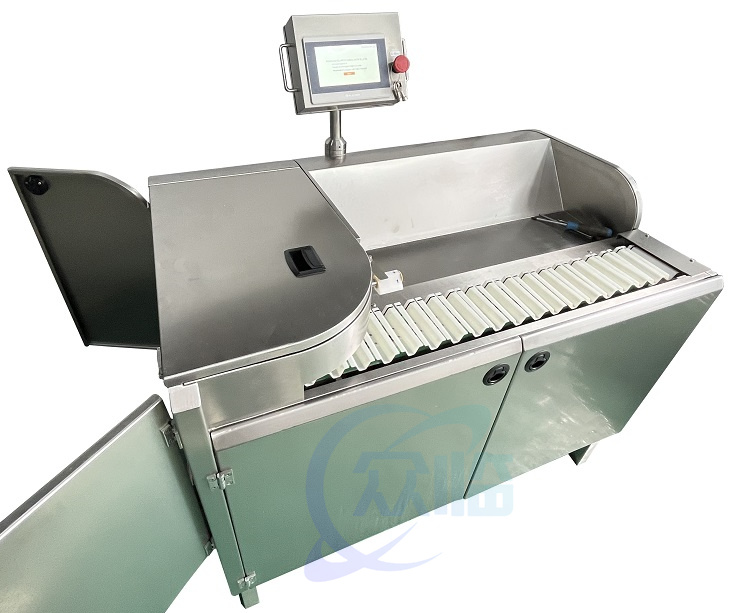
Shrimp Peeling Machine
Brown shrimp and pink shrimp from inshore waters are still normally peeled by hand, but machines are now available that will handle the larger deepwater shrimp.
In hand peeling, the body of the shrimp is held in one hand, and the head twisted off with the other. The first two or three segments of shell are then broken open with the thumb, and the tail is squeezed to release the meat. A skilled worker can peel 2½-3 kg whole shrimp an hour.
China peeling machines are now available commercially that can handle deepwater shrimp. Successive pairs of rollers behead the shrimp, split the shell along the back and pull the shell from the meats. Output depends on the size of shrimp, but a single machine can peel as much shrimp as 16 hand workers.
Shrimp are often consumed without any further cooking; therefore particular attention must be paid to hygiene and sanitation. Regular bacteriological control of processing is important for this type of product. The main source of bacterial contamination of cooked shrimp is the peeling process, particularly hand peeling. Workers must wash their hands frequently, and all working surfaces must be kept scrupulously clean. Recommended procedures for factory cleaning are given in Advisory Note 45 'Cleaning in the fish industry'. The use of chlorinated water on the processing line can be of considerable help in keeping down contamination, but shrimp waste must not be allowed to accumulate since the chlorine is rapidly inactivated by protein. The shrimp must be kept cool throughout the process.
Machine peeling results in far less recontamination of cooked shrimp than hand peeling. Provided the peeling machines are cleaned at frequent intervals, the risk of increasing spoilage or introducing food poisoning bacteria is much less with machine peeling than with hand peeling.
Where raw meats are required for further processing, thawed frozen whole shrimp are much easier to peel than very fresh unfrozen shrimp. Peeling of unfrozen shrimp becomes easier after 1-2 days chilled storage.
>> Shop for Zolim Shrimp Peeling Machine here
Foshan Zolim Technology Co., Ltd is a professional research, producer and exporter of seafood processing machinery. We offer the full range of commodity shrimp processing machines you need. If you are interested in our products, please contact us now!
- Category:
- Business
- No comments


